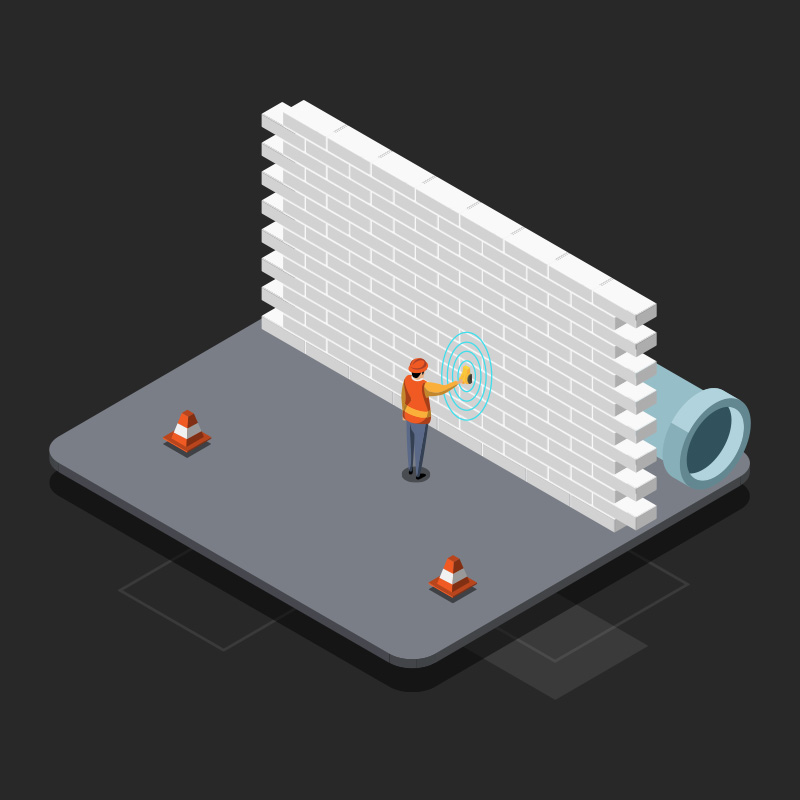Trick Benefits of Using Concrete Scanning Modern Technology
Trick Benefits of Using Concrete Scanning Modern Technology
Blog Article
Unveil the Transformative Power of Concrete Scanning in Optimizing Efficiency and Safety And Security
Concrete scanning has emerged as a crucial tool in the building market, using unrivaled advantages in improving job effectiveness and making certain safety requirements. The transformative power of concrete scanning exists in its capability to give real-time information and detailed insights, transforming just how projects are planned and executed.
Relevance of Concrete Scanning
Guaranteeing the structural integrity and safety and security of building and construction jobs starts with the vital step of conducting thorough concrete scanning. Concrete scanning is a non-destructive approach made use of to detect and map subsurface elements within concrete frameworks. This process is necessary in identifying possible threats, such as rebar, post-tension cable televisions, and conduits, that may be hidden within the concrete. By making use of sophisticated technologies like ground-penetrating radar (GPR) and electro-magnetic induction, construction groups can precisely find these elements without creating any damages to the structure.
In addition, concrete scanning aids in maximizing task timelines and budget by avoiding unanticipated prices and hold-ups that might emerge due to unforeseen blockages within the concrete. Inevitably, spending in detailed concrete scanning is a proactive method that enhances both efficiency and safety in building and construction jobs.
Just How Concrete Scanning Functions
Concrete scanning runs as a critical tool in building and construction tasks by utilizing innovative technologies to spot and map subsurface elements without triggering structural damage. Ground Permeating Radar (GPR) and Electromagnetic Induction (EMI) are two key techniques used in concrete scanning.
During the scanning procedure, the information gathered is examined in real-time, enabling prompt identification of prospective hazards or challenges underneath the surface. This info help in decision-making, making sure that construction activities continue securely and efficiently. Furthermore, 3D imaging software program can be made use of to produce detailed maps of the subsurface aspects, better enhancing job planning and implementation. By using these advanced innovations, concrete scanning considerably decreases the risk of costly problems and injuries on building and construction sites.
Benefits of Concrete Scanning
One of the key benefits of concrete scanning is the capacity to find and locate ingrained items such as rebar, post-tension cables, and channels accurately. Concrete scanning assists in preparation and making a lot more successfully, as it provides exact info regarding the location and deepness of architectural elements.

Instance Research Studies: Concrete Scanning Success

In another situation, a construction firm used 3D concrete scanning to assess the condition old concrete frameworks in a historical structure. The comprehensive scans supplied valuable understandings into the degree of deterioration and helped prioritize upkeep efforts properly. By proactively addressing areas of worry recognized through scanning, the firm was able to expand the lifespan of the structure and make sure owner safety.
These study emphasize the transformative power of concrete scanning in boosting performance, precision, and safety and security in construction jobs.
Carrying Out Concrete Scanning in Projects
Carrying out innovative scanning modern technologies throughout building tasks has actually come to be significantly essential for enhancing precision and safety and security. By incorporating concrete scanning right into job planning and execution, building groups can recognize potential hazards, such as rebar or post-tension cables, hidden within concrete frameworks. This aggressive strategy decreases the danger of mishaps, delays, and pricey rework, eventually bring about a lot more effective project timelines and budgets.
To implement concrete scanning properly, job managers should team up very closely with knowledgeable scanning professionals to identify Web Site one of the most ideal scanning strategies for the specific task demands. Involving scanning professionals from the beginning of a job enables the group to produce detailed scanning plans that resolve crucial areas of problem and guarantee detailed information collection.
Furthermore, incorporating concrete scanning right into regular job operations can enhance decision-making procedures, as real-time check information offers immediate understandings into the problem of concrete structures - Concrete Scanning. This data-driven strategy assists in informed analytic and allows groups to make modifications promptly, cultivating a culture of effectiveness and safety throughout the job lifecycle

Final Thought
In final thought, concrete scanning plays a crucial function in boosting efficiency and safety in building and construction tasks. By making use of sophisticated modern technology to map and identify out underlying structures within concrete, this process aids to prevent costly blunders, make sure architectural honesty, and lessen risks on site. With the ability to discover concealed elements and provide precise information, concrete scanning confirms to be an important device for enhancing job results and making the most of general success.
Concrete scanning is a non-destructive technique used to find and map subsurface elements within concrete structures. Additionally, concrete scanning helps in enhancing task timelines and budget by avoiding unexpected costs and hold-ups that might occur due to have a peek here unexpected blockages within the concrete. One noteworthy instance research entails a massive restoration task where concrete scanning played a crucial duty in making certain job success.In one more case, a construction business used 3D concrete scanning to evaluate the condition of maturing concrete structures in a historic building. By incorporating concrete scanning right into project planning and implementation, building and construction groups can recognize prospective risks, such as rebar or post-tension cable televisions, hidden within concrete structures.
Report this page